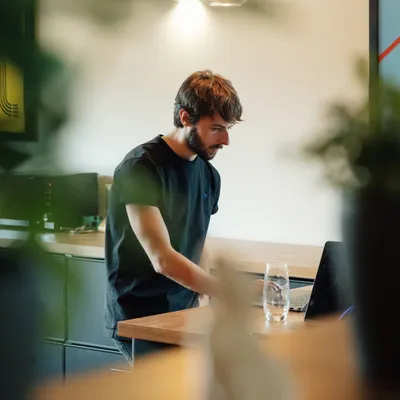How long does it take to build a website these days? Let’s find out


Yeah, we know it's cliche. But it’s still relevant when asking a developer how long it takes to build a website.
By 2022, you’d think the process would be relatively speedy. Well, that’s if the latest figures are anything to go by; staggeringly, there are around 1.88 billion websites online today and 175 are created per minute.
But that’s not necessarily the case. There are so many variables that can affect development time, usually led by details raised in the project discovery phase. These come from questions like:
Are you using a platform or starting from scratch?
What is the scope of the project?
What are your goals and objectives?
Who is your target audience?
And what functionality are you expecting?
And that’s just scratching the surface. Taking these factors into consideration, building a website could take anywhere between a few hours and several months.
That doesn’t really narrow it down though, does it?
To get more specific, we’re going to talk about the platforms we champion the most and develop with at Shape: Shopify and Craft CMS.

The great thing about Shopify is it’s an “out of the box” solution. And that means your site could be live 5-6 times quicker than other bespoke website builders. In theory, you could be up and running in a couple of weeks.
But before starting a Shopify site with us, there are a few admin bits to take care of on your side:
Create a Shopify account - it’s quick and easy to do, just submit your details here.
Set up billing details - payment will kick in after the 14-day trial period.
Give us access - let us know what your Shopify URL is so we can request access.
Don’t worry, this won’t take long. And once you’ve completed these simple steps, we’re all set to immediately kick off the project with you.
From then on, it’s plain sailing. Here’s what you can expect…
On our side, development is relatively straightforward. In part, that’s because Shopify’s a hosted platform. This means we can work on perfecting what’s already there - as opposed to doing any heavy coding.
On top of over100 pre-built themes that can be customised to your needs, there’s also an abundance of plugins in the Shopify App Store. So if there isn’t a feature already built into your website, there will almost always be a Shopify plugin that can do the job for you. It’s these features that make front-end development in Shopify so swift - perfect if you're in a hurry to get going.
Whether you’re an experienced merchant or a first-time seller, Shopify’s the ideal choice for those looking to race into the marketplace. That’s because it comes complete with all the tools most eCommerce businesses need to sell online.
Obviously, this speeds up the development process on our side too.
Many crucial features that often take up a lot of development time are already good to go. For example, Shopify’s out-of-the-box checkout is quick and easy to install and equips businesses with everything they need to convert prospects into sales.
But it’s not just relatively straightforward for us to develop; it’s easy for you to use as well.
Essentially, this platform is tailor-made for people who aren’t necessarily tech-savvy; time-strapped businesses that want to focus on selling their products - without worrying about the logistics. These are just some of the benefits of Shopify that make it dead easy to use:
Intuitive and user-friendly CMS - this makes managing products, variants, collections, tags and shipping models quick and easy.
Simple SEO optimisation - most fundamental SEO features are already baked into Shopify. So optimising your site is one less thing you need to worry about.
Huge variety of templates - Shopify has a huge variety of free and premium designs to choose from. All professional-looking and, crucially, ready for mobile.
So, how long does it really take to build a Shopify site?
Yes, you could be up and running in a couple of weeks but that’s if you've got a clear idea of what you're looking for - perhaps without all the bells and whistles. Our advice is to have a realistic plan and not rush a thing. Be sure every decision you make is the right one for your business and you’ll benefit so much more when your site does eventually go live.
Developing a website with Craft CMS, on the other hand, is another story entirely. Before our developers even touch a single string of code, there’s some serious design thinking to do.

Developing a website using Craft CMS takes longer than Shopify - but that’s because the customisation possibilities are almost endless. Craft CMS is like a blank canvas and the only limit’s your imagination. A lot of time is required for the design and development stages, therefore the time frame is a minimum of 4 weeks.
As everything is built from the ground up with Craft CMS, it’s essential a lot of thought and effort goes into design discovery and exploration, before any development starts.
Working alongside each client, our design process is as follows:
Research and direction - a deep dive into exactly what it is you're looking for. What are your competitors doing? How can we create a sense of distinction whilst still delivering what users and search engines are expecting? We’ll get a real sense of the size and scope of the project in this discovery phase.
Create and share sample pages - once we’ve got an idea of what you’re looking for, we’ll design mockups and send the first few pages for review.
Discuss initial client feedback - you can be brutally honest here. Are we heading in the right direction or way off the mark? The good thing is, after that thorough discovery session, these initial designs are always led by insights.
More pages for review - after dipping our toe with the first few pages and taking on board your comments, we’ll design a few more so you can get a clearer picture of where things are heading.
The final round of feedback - it’s not over yet, there’s still time to make changes to the final designs.
Complete the rest of the page designs - at this stage, everything should be mapped out and agreed upon. So that's it, absolutely no surprises down the road.
The design stage is a back and forth process and we won't move on to the development phase until all stakeholders have signed off. With that in mind, the time frame very much depends on the scale of the project. Obviously, the more time spent in this phase will impact how long it takes to build the website. But there are no templates here, so it's important to get things right.
Now, onto the build.
In terms of page content and structure, Craft CMS encourages creativity to flow.
That’s because Craft’s ‘matrix fields’ allow you to build multiple content blocks within a single space. Essentially, you can create as many as you like with any number of fields. You can also position them wherever works best for the page layout.
Sound like a lengthy process? Sure, it can be.
But this functionality gives developers and content creators unrivalled flexibility. It allows them to ensure every one of your website pages is unique and engaging. Perfect for boosting the user experience and ensuring visitors stick around a little longer. Importantly, Craft CMS lets you preview every page as if it was ‘live’ so you can get a feel for how it’ll look in the real world.
These are all major benefits of using Craft CMS and make for a smooth and painless development process. But you know what? Perfection still takes time.
Luckily, there are ways we can ensure you hit the ground running when your site does go live.
Craft CMS has a respectable number of plugins, for sure. But this isn’t its major selling point. The fact is, with an abundance of features already baked into its core, Craft CMS doesn’t need a bunch of add-ons to function effectively.
However, there are certain plugins that we install for our clients as standard to make their lives easier. These include:
Blitz - static page caching to ensure your site stays super fast
SEOMatic - keeping your site optimised using all modern SEO best practices
Super Table - simplify your workflow and group matrix fields together with ease
Sprout Reports - powerful custom website reporting
We also include a bunch more - all tasked with ensuring your site is firing on all cylinders from the offset.
But we know that no two Craft CMS projects are ever exactly the same. In fact, some require more complicated functionality which means our developers need to build their own plugins. The good thing is that although this adds a bit more development time, Craft’s API makes it easy to do. We’ve talked a little bit more about the types of plugins we’ve developed for Craft CMS here.
So, with all this in mind, how long does it really take to build a website using Craft CMS? At Shape, we would say a minimum of 4 weeks of development time.
However, please bear in mind that the time frames in this post are rough estimates; you should allow for extra time depending on the project's size and scope.

With over a decade of experience in web design and development, it's safe to say we're pretty busy these days and our diaries tend to get booked up in advance. With that in mind, it's unlikely we’ll be able to get cracking on a development project immediately - but we're always free to start the conversation. And when we do begin the process of developing your site, well, we can promise it’ll be worth the wait!
Looking for experts in website development? Get in touch to chat about your project requirements today.
Account Manager and chocoholic at Shape.